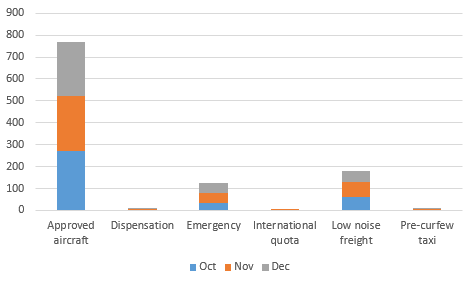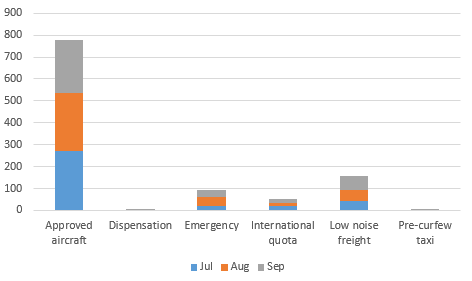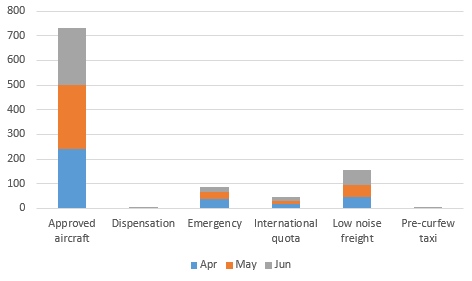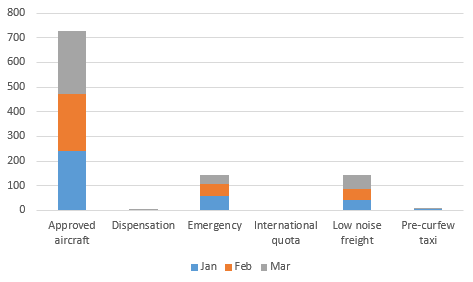Movements
Movement data is no longer updated on this page. Please refer to the Movements at Australian airports webpage or the WebTrak program for movement data.
Select a quarter for information on movements at Adelaide Airport during that the period.
Total movements
In quarter three there were 26 109 movements at Adelaide Airport, ranging from 9068 to 8209 movements per month. On average, in each month of the quarter there were:
- around 4970 jet movements
- around 3500 propeller and turbo-prop movements
- around 225 helicopter movements.
The busiest month for jet movements was July with 5283 movements and September had the fewest with 4622 movements.
Hourly movements (average)
Daily movements (average and maximum)
Curfew movements
Curfew category
Certain types of operations are permitted to operate in limited numbers during the curfew period. Refer to the Department of Infrastructure and Regional Development for further details about permitted operations during the curfew.
Curfew runway use
During the curfew period aircraft (excluding helicopters) must arrive on Runway 05 and depart on Runway 23, over the water, unless this is not operationally feasible, for example, due to the wind conditions.
This graph shows the total number of curfew movements that arrived on Runway 05 and departed from Runway 23 in the quarter, compared to other movements in the curfew period, including helipad movements. This is broken down by each hour of the curfew.
Total movements
In quarter two there were 25 950 movements at Adelaide Airport, ranging from 8335 to 8937 movements per month. On average, in each month of the quarter there were:
- around 4890 jet movements
- around 3480 propeller and turbo-prop movements
- around 260 helicopter movements.
The busiest month for jet movements was May with 5014 movements and June had the fewest with 4692 movements.
Hourly movements (average)
Daily movements (average and maximum)
Curfew movements
Curfew category
Certain types of operations are permitted to operate in limited numbers during the curfew period. Refer to the Department of Infrastructure and Regional Development for further details about permitted operations during the curfew.
Curfew runway use
During the curfew period aircraft (excluding helicopters) must arrive on Runway 05 and depart on Runway 23, over the water, unless this is not operationally feasible, for example, due to the wind conditions.
This graph shows the total number of curfew movements that arrived on Runway 05 and departed from Runway 23 in the quarter, compared to other movements in the curfew period, including helipad movements. This is broken down by each hour of the curfew.
Total movements
In quarter one there were 25 691 movements at Adelaide Airport, ranging from 8143 to 8977 movements per month. On average, in each month of the quarter there were:
- around 4900 jet movements
- around 3300 propeller and turbo-prop movements
- around 270 helicopter movements.
The busiest month for jet movements was March with 5119 movements and February had the fewest with 4637 movements. The holiday period in January would have contributed to higher jet movements during that month, while the fewer days in the month of February would have contributed to the lower number of jet movements.
Hourly movements (average)
Daily movements (average and maximum)
Curfew movements
Curfew category
Certain types of operations are permitted to operate in limited numbers during the curfew period. Refer to the Department of Infrastructure and Regional Development for further details about permitted operations during the curfew.
Curfew runway use
During the curfew period aircraft (excluding helicopters) must arrive on Runway 05 and depart on Runway 23, over the water, unless this is not operationally feasible, for example, due to the wind conditions.
This graph shows the total number of curfew movements that arrived on Runway 05 and departed from Runway 23 in the quarter, compared to other movements in the curfew period, including helipad movements. This is broken down by each hour of the curfew.
Total movements
In quarter four there were 26 371 movements at Adelaide Airport, ranging from 8506 to 9034 movements per month. On average, in each month of the quarter there were:
- around 5080 jet movements
- around 3430 propeller and turbo-prop movements
- around 280 helicopter movements.
The busiest month for jet movements was October with 5204 movements and November had the fewest with 4990 movements. School holidays in October in all states would have contributed to the higher aircraft movement numbers in that month.
Hourly movements (average)
Daily movements (average and maximum)
Curfew movements
Curfew category
Certain types of operations are permitted to operate in limited numbers during the curfew period. Refer to the Department of Infrastructure and Regional Development for further details about permitted operations during the curfew.
Curfew runway use
During the curfew period aircraft (excluding helicopters) must arrive on Runway 05 and depart on Runway 23, over the water, unless this is not operationally feasible, for example, due to the wind conditions.
This graph shows the total number of curfew movements that arrived on Runway 05 and departed from Runway 23 in the quarter, compared to other movements in the curfew period, including helipad movements. This is broken down by each hour of the curfew.
Total movements
In quarter three there were 26 274 movements at Adelaide Airport, ranging from 8696 to 8838 movements per month. On average, in each month of the quarter there were:
- around 5000 jet movements
- around 3500 propeller and turbo-prop movements
- around 250 helicopter movements.
The busiest month for jet movements was July with 5121 movements and September had the fewest with 4915 movements. School holiday periods across different States would have affected movements in both of these months. While September recorded the fewest number of movements, it was still an increase of approximately 300 movements from the fewest movements of quarter two.
Hourly movements (average)
Daily movements (average and maximum)
Curfew movements
Curfew category
Certain types of operations are permitted to operate in limited numbers during the curfew period. Refer to the Department of Infrastructure and Regional Development for further details about permitted operations during the curfew.
Curfew runway use
During the curfew period aircraft (excluding helicopters) must arrive on Runway 05 and depart on Runway 23, over the water, unless this is not operationally feasible, for example, due to the wind conditions.
This graph shows the total number of curfew movements that arrived on Runway 05 and departed from Runway 23 in the quarter, compared to other movements in the curfew period, including helipad movements. This is broken down by each hour of the curfew.
Total movements
In quarter two there were 25 343 movements at Adelaide Airport, ranging from 8188 to 8608 movements per month. On average, in each month of the quarter there were:
- around 4800 jet movements
- around 3300 propeller and turbo-prop movements
- around 270 helicopter movements.
The busiest month for jet movements was April with 4952 movements and June had the fewest with 4677 movements. The Easter long weekend and school holidays would have affected operations in April.
Hourly movements (average)
Daily movements (average and maximum)
Curfew movements
Curfew category
Certain types of operations are permitted to operate in limited numbers during the curfew period. Refer to the Department of Infrastructure and Regional Development for further details about permitted operations during the curfew.
Curfew runway use
During the curfew period aircraft (excluding helicopters) must arrive on Runway 05 and depart on Runway 23, over the water, unless this is not operationally feasible, for example, due to the wind conditions.
This graph shows the total number of curfew movements that arrived on Runway 05 and departed from Runway 23 in the quarter, compared to other movements in the curfew period, including helipad movements. This is broken down by each hour of the curfew.
Total movements
In quarter one there were 25 689 movements at Adelaide Airport, ranging from 8135 to 8973 movements per month. On average, in each month of the quarter there were:
- around 5000 jet movements
- around 3300 propeller and turbo-prop movements
- around 280 helicopter movements.
Helicopter movements were highest in January, due to the broadcast and media activities associated with the Tour Down Under.
The busiest month for jet movements was March with 5114 movements and February had the fewest with 4562 movements.
Hourly movements (average)
Daily movements (average and maximum)
Curfew movements
Curfew category
Certain types of operations are permitted to operate in limited numbers during the curfew period. Refer to the Department of Infrastructure and Regional Development for further details about permitted operations during the curfew.
Curfew runway use
During the curfew period aircraft (excluding helicopters) must arrive on Runway 05 and depart on Runway 23, over the water, unless this is not operationally feasible, for example, due to the wind conditions.
This graph shows the total number of curfew movements that arrived on Runway 05 and departed from Runway 23 in the quarter, compared to other movements in the curfew period, including helipad movements. This is broken down by each hour of the curfew.
Total movements
In quarter four there were 26 474 movements at Adelaide Airport, ranging from 8753 to 8942 movements per month. On average, in each month of the quarter there were:
- around 5000 jet movements
- around 3500 propeller and turbo-prop movements
- around 250 helicopter movements.
The busiest month for jet movements was December with 5137 movements and November had the fewest with 4977 movements.
Hourly movements (average)
Daily movements (average and maximum)
Curfew movements
Curfew category
Certain types of operations are permitted to operate in limited numbers during the curfew period. Refer to the Department of Infrastructure and Regional Development for further details about permitted operations during the curfew.
Curfew runway use
During the curfew period aircraft (excluding helicopters) must arrive on Runway 05 and depart on Runway 23, over the water, unless this is not operationally feasible, for example, due to the wind conditions.
This graph shows the total number of curfew movements that arrived on Runway 05 and departed from Runway 23 in the quarter, compared to other movements in the curfew period, including helipad movements. This is broken down by each hour of the curfew.
Total movements
In quarter three there were 26 134 movements, ranging from 8571 to 8784 movements per month. On average, in each month of the quarter there were:
- around 5000 jet movements
- around 3500 propeller and turbo-prop movements
- around 250 helicopter movements.
These figures are consistent with the previous quarter.
The busiest month for jet movements was July with 4974 and August was the lightest with 4875.
Hourly movements (average)
Daily movements (average and maximum)
Curfew movements
Curfew category
Certain types of operations are permitted to operate in limited numbers during the curfew period. Refer to the Department of Infrastructure and Regional Development for further details about permitted operations during the curfew.
Curfew runway use
During the curfew period aircraft (excluding helicopters) must arrive on Runway 05 and depart on Runway 23, over the water, unless this is not operationally feasible, for example, due to the wind conditions.
This graph shows the total number of curfew movements that arrived on Runway 05 and departed from Runway 23 in the quarter, compared to other movements in the curfew period, including helipad movements. This is broken down by each hour of the curfew.
Total movements
In quarter two there were 25530 movements, ranging from 8386 to 8746 movements per month. On average, in each month of the quarter there were:
- around 4750 jet movements
- around 3500 propeller and turbo-prop movements
- around 260 helicopter movements.
The busiest month for jet movements was April with 4876 and June was the lightest with 4605.
Hourly movements (average)
Daily movements (average and maximum)
Curfew movements
Curfew category
Certain types of operations are permitted to operate in limited numbers during the curfew period. Refer to the Department of Infrastructure and Regional Development for further details about permitted operations during the curfew.
Curfew runway use
During the curfew period aircraft (excluding helicopters) must arrive on Runway 05 and depart on Runway 23, over the water, unless this is not operationally feasible, for example, due to the wind conditions.
This graph shows the total number of curfew movements that arrived on Runway 05 and departed from Runway 23 in the quarter, compared to other movements in the curfew period, including helipad movements. This is broken down by each hour of the curfew.
Total movements
There were around 25 700 total movements in quarter one, between 8300 and 9200 per month. On average, in each month of the quarter there were:
- around 5000 jet movements
- around 3300 propeller and turbo-prop movements
- around 280 helicopter movements.
The busiest month was March with 9195 movements overall and 5218 of these were jets. Helicopter movements dropped from the previous quarter and from the same quarter in 2016.
Hourly movements (average)
Daily movements (average and maximum)
Curfew movements
Total movements
There were 1082 movements during the curfew including 89 helicopter movements.
Curfew category
Certain types of operations are permitted to operate in limited numbers during the curfew period. Refer to the Department of Infrastructure and Regional Development for further details about permitted operations during the curfew.

Curfew runway use
During the curfew period aircraft (excluding helicopters) must arrive on Runway 05 and depart on Runway 23, over the water, unless this is not operationally feasible, for example, due to the wind conditions.
This graph shows the total number of curfew movements that arrived on Runway 05 and departed from Runway 23 in the quarter, compared to other movements in the curfew period, including helipad movements. This is broken down by each hour of the curfew.
Jet movements peaked in October 2016 at 5151 movements. The month with the lowest number of jet movements was June, with 4664.
There were 3636 helicopter movements during 2016. This is on par with 2015 when there were 3662.
Total movements
There were approximately 26 500 total movements in quarter four, between 8500 and 9000 per month. On average, in each month of the quarter there were:
- around 5000 jet movements
- around 3400 propeller and turbo-prop movements
- around 335 helicopter movements.
Hourly movements (average)
Daily movements (average and maximum)
Curfew movements
Total movements
There were 1082 movements during the curfew including 89 helicopter movements.
Curfew category
Certain types of operations are permitted to operate in limited numbers during the curfew period. Refer to the Department of Infrastructure and Regional Development for further details about permitted operations during the curfew.

Curfew runway use
During the curfew period aircraft (excluding helicopters) must arrive on Runway 05 and depart on Runway 23, over the water, unless this is not operationally feasible, for example, due to the wind conditions.
This graph shows the total number of curfew movements that arrived on Runway 05 and departed from Runway 23 in the quarter, compared to other movements in the curfew period, including helipad movements. This is broken down by each hour of the curfew.
Total movements
There were approximately 26 000 total movements in quarter three, between 8500 and 9000 per month. On average, in each month of the quarter there were:
- around 5000 jet movements
- around 3400 propeller and turbo-prop movements
- around 250 helicopter movements.
Hourly movements (average)
Daily movements (average and maximum)
Curfew movements
Total movements
There were 1082 movements during the curfew including 89 helicopter movements.
Curfew category
Certain types of operations are permitted to operate in limited numbers during the curfew period. Refer to the Department of Infrastructure and Regional Development for further details about permitted operations during the curfew.

Curfew runway use
During the curfew period aircraft (excluding helicopters) must arrive on Runway 05 and depart on Runway 23, over the water, unless this is not operationally feasible, for example, due to the wind conditions.
This graph shows the total number of curfew movements that arrived on Runway 05 and departed from Runway 23 in the quarter, compared to other movements in the curfew period, including helipad movements. This is broken down by each hour of the curfew.
Comparison of the chart above with the previous two quarters shows that there was a drop in usage of the preferred curfew runway configuration during quarter three. This was due to the wind conditions during the quarter, which allowed fewer periods when all operations could take place over the bay.
Total movements
In quarter two there were approximately 25 000 movements, between 8200 and 8500 per month. On average in each month in the quarter there were:
- around 5000 jet movements
- around 3300 propeller and turbo-prop aircraft movements
- around 275 helicopter movements.
Hourly movements (average)
Daily movements (average and maximum)
Curfew movements
Total movements
There were 1034 movements during the curfew including 88 helicopter movements.
Curfew category
Certain types of operations are permitted to operate in limited numbers during the curfew period. Refer to the Department of Infrastructure and Regional Development for further details about permitted operations during the curfew.

Curfew runway use
During the curfew period aircraft (excluding helicopters) must arrive on Runway 05 and depart on Runway 23, over the water, unless this is not operationally feasible, for example, due to the wind conditions.
This graph shows the total number of curfew movements that arrived on Runway 05 and departed from Runway 23 in the quarter, compared to other movements in the curfew period, including helipad movements. This is broken down by each hour of the curfew.
Total movements
There were around 25 000 total movements this quarter. On average, in each month of the quarter there were:
- around 5000 jet movements
- around 3000 propeller and turbo-prop movements
- around 350 helicopter movements.
Hourly movements (average)
Daily movements (average and maximum)
Curfew movements
Total movements
There were 1022 movements during the curfew in quarter 1, including 141 helicopter movements. Apart from one helicopter movement that was categorised as an approved aircraft (see below), all the other helicopter movements were emergency services.
Curfew category
Certain types of operations are permitted to operate in limited numbers during the curfew period. Refer to the Department of Infrastructure and Regional Development for further details about permitted operations during the curfew.

Curfew runway use
During the curfew period aircraft must arrive on Runway 05 and depart on Runway 23, over the water, unless this is not operationally feasible, for example, due to the wind conditions.
This graph shows the total number of curfew movements that arrived on Runway 05 and departed from Runway 23 in the quarter, compared to other movements in the curfew period, including helipad movements. This is broken down by each hour of the curfew.